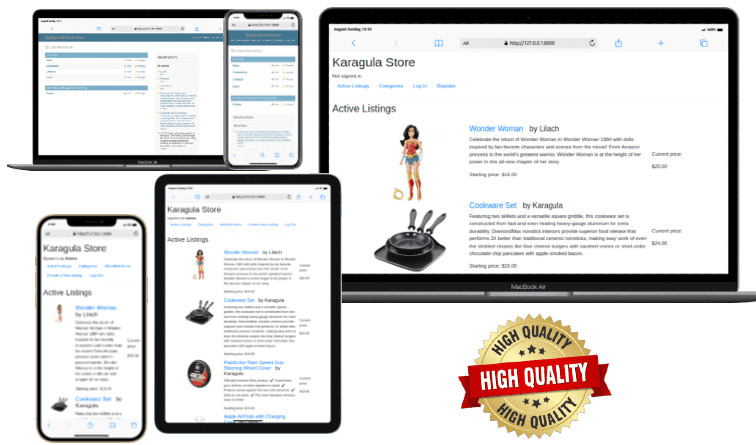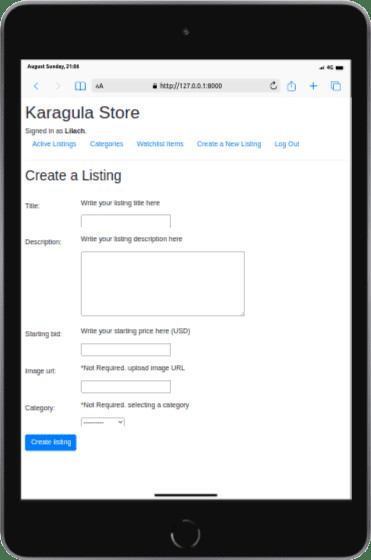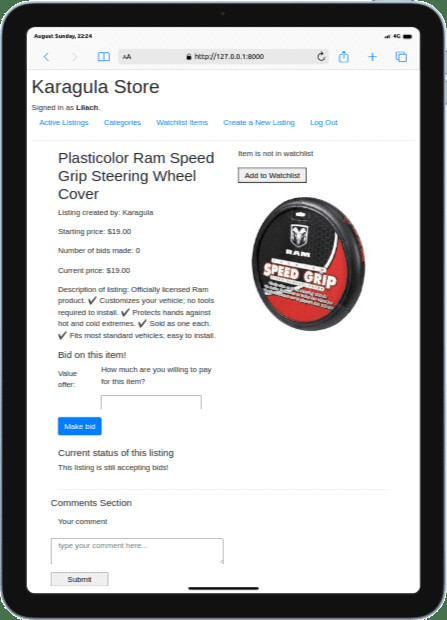eBay style e commerce auction web application with Django framework
Desarrollador
Hablar con el vendedor
Detalles del producto
n this project, I've developed an eBay-style e-commerce auction site that allows users to post-auction listings, place bids on listings, comment on those listings, and add listings to a “watchlist”.
Create Listing: Any user can create a new listing.
The users can specify a title for the listing, a text-based description, and the starting bid.
Additionally, users also optionally can provide a URL for an image for the listing and/or a category (e.g. Fashion, Toys, Electronics, Home, etc.).
Active Listings Page: The default route of my web application lets users view all of the currently active auction listings.
For each active listing, this page displays the title, description, current price, and photo.
Listing Page: Clicking on a listing takes users to a page specific to that listing.
On that page, users can view all details about the listing, including the current price for the listing.
If the user is signed in, the user can add the item to their “Watchlist”.
If the item is already on the watchlist, the user can remove it.
If the user is signed in, he can bid on the item.
The bid must be at least as large as the starting bid and must be greater than any other bids that have been placed (if any).
If the bid doesn’t meet those criteria, the user is presented with an error.
If the user is signed in and is the one who created the listing, the user can “close” the auction from this page, which makes the highest bidder the winner of the auction and makes the listing no longer active.
If a user is signed in on a closed listing page and has won that auction, the page will say so.
Users who are signed in can add comments to the listing page.
The listing page displays all comments that have been made on the listing.
Watchlist: Users who are signed in can visit a Watchlist page, which displays all of the listings that a user has added to their watchlist. Clicking on any of those listings will take the user to that listing’s page.
Categories: Users can visit a page that displays a list of all listing categories.
Clicking on the name of any category will take the user to a page that displays all of the active listings in that category.
Django Admin Interface: Via the Django admin interface, a site administrator can view, add, edit, and delete any listings, comments, and bids made on the site.
YouTube introduction: https://www.youtube.com/watch?v=wyqxK9SyQlI
1. Create Listing: Any user can create a new listing.2. Active Listings Page: The default route of my web application lets users view all of the currently active auction listings.
3. Listing Page: Clicking on a listing takes users to a page specific to that listing.
On that page, users can view all details about the listing, including the current price for the listing.
4. Watchlist: Users who are signed in can visit a Watchlist page, which displays all of the listings that a user has added to their watchlist.
5. Categories: Users can visit a page that displays a list of all listing categories.
6. Django Admin Interface: Via the Django admin interface, a site administrator can view, add, edit, and delete any listings, comments, and bids made on the site.
File Tree
-
📁 eBay style e commerce auction web application with Django framework











 Añadir al carrito
Añadir al carrito











